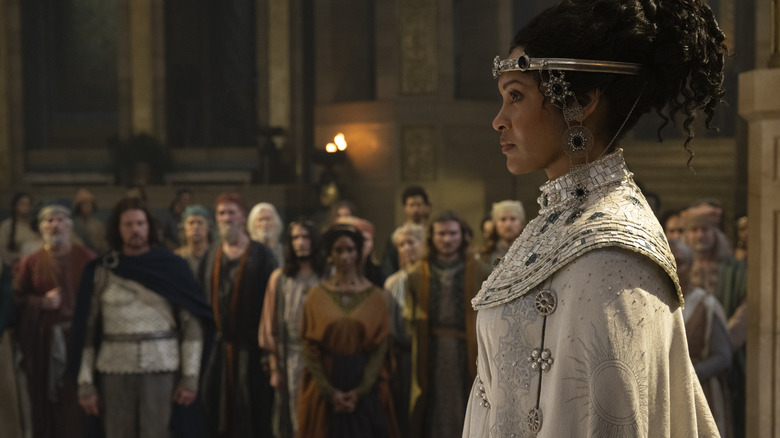The Rings Of Power – The Palantír, Explained
Three Rings for the Elven-kings under the sky, Seven for the Dwarf-lords in their halls of stone, Nine for Mortal Men doomed to die, and one spoiler warning for those who haven’t watched the first three episodes of “The Lord of the Rings: The Rings of Power” season 2.
Don’t sleep on one of the most sneakily important storylines in all of “The Rings of Power.” Compared to the surprisingly melodramatic intrigue between Morfydd Clark’s Galadriel and Charlie Vickers’ shapeshifting Halbrand/Sauron/Annatar or the more conventional journey of the Harfoot Nori (Markella Kavenagh) and The Stranger (Daniel Weyman), viewers would be forgiven for overlooking the political subplot currently taking shape over on the island kingdom of Númenor. After all, these characters don’t even appear on the scene until the third episode of the season 2 premiere, but showrunners J.D. Payne and Patrick McKay quickly make up for lost time. After kicking off with an entire scene we already saw back in the first season between Elendil (Lloyd Owen) and the horse of his missing son Isildur (Maxim Baldry), we eventually segue back to the distant island nation and what can only be described as an attempted coup in the works. Suffice to say, this is one subplot you’ll want to pay attention to moving forward.
Here, as first established in season 1, the mysterious orb known as the palantír continues to play a major role … though viewers who haven’t brushed up on their Middle-earth lore might need a bit of a refresher. J.R.R. Tolkien’s lore spends quite a bit of time and space on these powerful objects, as did Peter Jackson’s “The Lord of the Rings” trilogy. In “The Rings of Power,” the palantír might very well be what makes or breaks this kingdom.
What are the palantíri?
Before anyone accuses the Númenorean subplot of being out on an island by itself (see what I did there?), it’s worth remembering just where these “seeing stones” known as the palantíri came from in the first place and how closely linked this storyline actually is with the elves. There’s one moment in season 1 between the great elven craftsman (crafts-elf?) Celebrimbor and his right hand man (right hand elf? Okay, I’ll stop now) Elrond, played by Charles Edwards and Robert Aramayo respectively, where the former waxes poetic about the legendary works wrought by Fëanor and his ambitions to make something even more beautiful in turn. In addition to creating the Silmaril gems that nearly “turned the heart of the Great Foe himself,” Fëanor also had a hand in bringing the various palantíri to life. In another scene between Galadriel and Queen Regent Míriel (Cynthia Addai-Robinson), the now-blind ruler laid out the backstory of these stones: A total of seven were made, specifically for the purpose of communicating with others across vast distances, and they even give users the ability to perceive visions and omens of future events. But every other palantír has since been lost to the centuries.
As we found out in season 1, Míriel has used this remaining palantír to gain a forewarning of Númenor’s watery fate should they keep turning their backs on their most ancient traditions. Naturally, she kept its existence hidden from everyone except Galadriel — and, unknowingly, Elendil’s nosy daughter Eärien (Ema Horvath). In the third episode of season 2, it becomes much clearer why it was such a mistake to let this secret out into the open.
How the palantír factors into season 2
When J.R.R. Tolkien chronicled the ultimate fate of Númenor in Middle-earth’s history books (as told in the appendices found at the end of his novel “The Return of the King”), the acclaimed fantasy author made sure to include plenty of room for the role that the palantíri played in perhaps his biggest tragedy. “The Rings of Power” has taken the source material and further expanded upon it, putting the seeing stones front and center of the kingdom’s central political turmoil.
Thanks to the explosive conclusion to season 1, the stage has already been set for some serious upheaval in Númenor. Upon returning from Middle-earth and her doomed campaign against Adar’s orcs in the Southlands, Míriel finds herself both physically blinded and politically under siege by her subjects grieving their many lost soldiers. When Eärien discovers that Míriel was at least partially motivated by the palantír to wage war in Middle-earth, it’s only a matter of time before she blows the whistle on this “dangerous” and “forbidden” object. The palantíri becoming public knowledge is one thing, but the narrative that the Queen Regent had become reliant on a tool of the elves (whom much of Númenor have spurned) inevitably turns the population against her. Matters reach a head during Míriel’s would-be coronation, which is completely upended by Eärien’s revelation and the untimely arrival of a Giant Eagle — a representative of the godlike Valar themselves — that seems to favor the rulership of the devious and conniving Pharazôn (Trystan Gravelle) over Míriel’s.
Has the palantír just ushered in the beginning of the end for Númenor? Stay tuned to find out. New episodes of “The Rings of Power” stream on Prime Video every Thursday.

















Post Comment